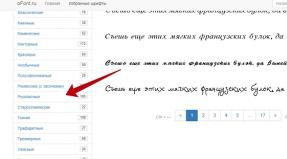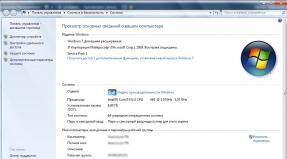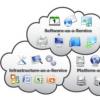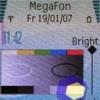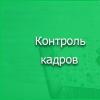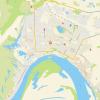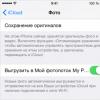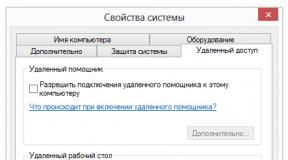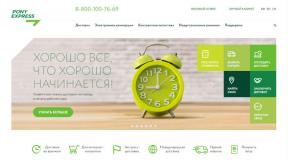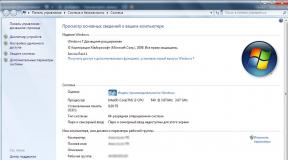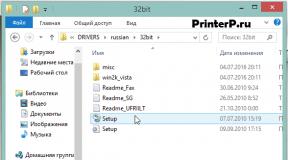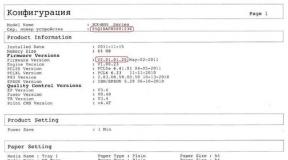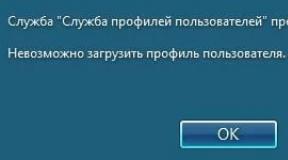Conducting information hours at school. Information classes at school
Information hour is a form of educational work among students aimed at nurturing the civic culture of young people, shaping their horizons and social maturity in conditions of political pluralism.
It is advisable to hold information hours weekly according to the training schedule. Based on the number of topics covered and the depth of discussion of the problem, information hours are divided into overview and thematic.
A review information hour is a brief overview of the main political, cultural and sporting events that occurred over a certain period of time in the country and abroad. It is proposed to inform students according to the following scheme:
State foreign policy (strategic directions of international activities, government visits and reception of delegations, signing of treaties, participation of the Republic of Belarus in resolving international conflicts);
State internal policy (the latest decrees, orders, ways to solve problems in various sectors, development trends in our society, republican events and economic achievements);
Latest events in the world;
Global environmental problems and ways to solve them;
News of science, culture, education, healthcare, sports of the Republic of Belarus, the CIS and other countries of the world.
The preparation stage involves, first of all, the selection of a presenter and the distribution of subtopics of the information hour among its participants. Those responsible for covering each direction and the presenter are pre-appointed by the curator or chosen by the students themselves. The role of the facilitator can be either the curator himself or one of the students; better, a group leader who can easily captivate peers and focus their attention on a specific problem. The curator (leader), if necessary, participates in the selection of relevant material, develops questions that specify the topic, determines personal and collective tasks for students, taking into account the level of culture and individual developmental characteristics of students, conducts individual consultations, and clarifies the purpose and plan for the information hour.
It is very important to teach students to independently select the necessary material for information hour. To do this, it is necessary to draw their attention to the main criteria for selecting information:
Relevance;
Objectivity;
Significance;
Credibility;
Efficiency;
Persuasiveness.
Students should be wary of materials of dubious origin, one-sided orientation, nationalist and chauvinistic orientation.
Students’ ability to use basic sources of information is of great importance. These include:
1. Periodicals.
2. Dictionaries and reference books.
3. Television programs.
4. Radio broadcasts.
5. Internet.
For a more in-depth discussion of any topical issue, it is advisable to hold thematic information hours.
Determining the topic is one of the most important aspects of preparing a thematic information hour. A formal approach to choosing a topic that does not take into account the most important requirements - the relevance of the information material. That is, its connection with the leading problems of youth, the state, and the world community leads to a decrease in personal interest and the educational impact of the information hour on students. From an educational point of view, such a position of the curator is very important, in which the teacher does not simply offer students the topic he has developed, but discusses it with them. The result of the collective discussion is a promising topic for the information hour, reviewed and approved by the students. As a result, from the first moment of preparing the information hour, students are placed in the position of active participants.
For the thematic information hour, questions specific to the topic are developed in advance, recommended literature is selected, visual aids, audio and video clips are prepared, and, if necessary, work is carried out on the Internet.
The course of the information hour is coordinated by the leader or curator of the study group. He communicates the topic, the purpose of the information hour, substantiates the relevance of the problem being discussed, and establishes the order of speakers.
When conducting an information hour, it is important not so much to pay attention to information about a particular event, but to arouse interest in it, make you think, read about the problem in a newspaper, magazine, book, and actively respond to what is happening. To this end, after each student’s message, the facilitator provides the group with the opportunity to:
Ask questions to the speaker;
Supplement messages with new facts and examples;
Exchange opinions;
Formulate conclusions on the issue under discussion.
After all presentations and discussions are completed, the presenter sums up the overall outcome of the information hour.
It is of interest to periodically conduct a review information hour with a free choice of topics (once every 4-6 weeks). Thematic areas in this case are not distributed, but it is mandatory for each student to prepare for the event that interests him most. The goal is to identify problems that are relevant from the point of view of young people; awakening creative search in the selection of material worthy of the attention of peers. Those who did not have time to speak are invited to place their materials indicating the name of the person who prepared them on a specially designed information stand.
A thematic information hour can be organized in the form of a conversation, during which students make reports on individual issues of the topic, or in the form of a discussion.
One of the varieties of thematic information hour is a “round table” with the presence of a person competent in the problem and the active involvement of students in the discussion. Information on the topic can be presented either by the invited guest himself or by the leader of the study group, who can easily arouse interest in the event and create an environment for a relaxed exchange of opinions.
It is advisable that the circle of participants in a thematic information hour is not limited to one study group. Meetings with interesting people, discussing current events in the world are an occasion to unite several groups of students, subject teachers, parents, and the administration of the educational institution at a round table. Decisions made at the round table can be sent to the relevant bodies and authorities in the form of recommendations, reviews, proposals, thanks, demands, concepts.
An activity-based approach to the study of state and political events develops in students a sense of involvement in what is happening in the world, increases everyone’s civic self-esteem, helps young people better understand the mechanisms of socio-economic processes and encourages active action to transform negative social phenomena.
To develop their concept and program of action in certain socio-economic areas, students can create elected initiative committees - information centers: environmental, national-patriotic, human rights, cultural relations, etc. It is advisable for the activities of such information centers to cover the following areas:
1. Invitation to information hours in groups of competent persons.
2. Information and educational work among students.
3. Organization of general school events (legal consultations, seminars, etc.).
4. Creation of information pages on the Internet in order to notify about your activities, search for like-minded people, exchange opinions, ideas, and experiences.
5. Participation in program events with supervising and equal partner organizations of their profile, training in relevant types of activities at trainings, seminars, etc.
Forms of holding information hours:
“Information +” is one of the most common forms of informing students, replacing such a well-known form as political information. This is to familiarize students with events in the country and abroad according to a certain scheme (foreign and domestic policies of the Republic of Belarus; development trends in Russia and the Commonwealth countries; events in foreign countries; news of science, culture, ecology, healthcare, sports). “+” indicates that in addition to presenting material on the topic, the speaker provides a demonstration of visual material, comments on the message, and exchanges opinions with the group.
“Inform Digest” is a weekly “five-minute meeting” with a free choice of topics. Each student, having previously analyzed the socio-political events of the past week, introduces the group to the most interesting and significant materials from the press, information radio and television programs.
“We asked - we answer” - a form of an overview information hour on pre-selected, most pressing issues for the children. First, information is collected from students about which events of modern life interested them most. The questions received are distributed among students in the class, then material is selected and presentations are prepared.
“Meetings with youth magazines” is a monthly overview information hour based on materials from youth magazines. The form of the event is students taking turns presenting a review and discussion of their favorite materials of a socio-political nature, published in the magazines “Coeval”, “Smena”, etc.
“Round table” is a form of studying a current social problem and freely exchanging opinions on it. The conversation can be started by a thematic presentation by the host or guest of the information hour, as well as by watching a video clip on the issue. After this, students complement the messages from the field, ask questions, a collective analysis of the problem and an active exchange of opinions are organized. In conclusion, conclusions are formulated on the topic (for example: “Youth rights in Belarus”, “Prevention of crime among youth”, etc.).
“Political Discussion” is a thematic information hour aimed at exploring problematic and controversial political issues. Participants are divided in advance into groups that have different or opposing opinions. The discussion is characterized by careful theoretical preparation of the participants and a thorough analysis of the argumentation of the opposing concept. As a result of collective creative thinking, students develop the ability to analyze political life, see the contradictions of reality and find ways to solve them.
“How It Was” is a form of a thematic information hour, analyzing one of the significant events following the example of the TV show of the same name. A major role is given to the leader (curator or the most prepared student). The host provides basic historical and political information, introduces guests and organizes dialogue. Speeches should be short (3-5 minutes) and devoted to a specific fact, allowing you to deepen and diversify the knowledge of listeners. It is recommended to use video materials, photo illustrations, etc.
“Years and People” is a thematic information hour dedicated to the biographies and professional achievements of cultural, political, and economic figures in our country and abroad.
“Press conference” is a form of information hour with elements of a role-playing game. Participants in the press conference - “journalists” and “photojournalists” - interview the speaker, who acts as a politician, scientist, artist, etc.
For a deeper discussion of any topical, interesting, relevant problem related to certain dates in the life of society, it is advisable to hold thematic information and educational hours.
How to organize and conduct a thematic informational and educational class hour
Stages of preparing a thematic information hour
1. Defining a theme - one of the most important moments in preparing a thematic information hour. From an educational point of view, such a position of the class teacher is very important, in which the teacher does not simply offer students the topic he has developed, but discusses it with them.
2. Collective discussion of the topic, the result of which is a promising topic for informational and educational hours reviewed and approved by the students. As a result, from the first moment of preparing the information hour, students are placed in the position of active participants.
For the thematic information hour, questions that specify the topic are developed in advance, recommended literature is selected, visual aids, audio and video clips are prepared, and, if necessary (and if possible), work is done on the Internet.
3. Summing up the discussion on the topic .
Forms of holding an information and educational hour- the most diverse. This may be a conversation during which students make reports on specific issues of the topic; discussion; KVN. The main thing is that the chosen form is most suitable for discussing the topic.
The children’s own videos also significantly increase interest in the issue covered during the thematic information hour: a “correspondent”, in the presence of a “cameraman” with a video camera, conducts a thematic blitz survey in a crowded place of his educational institution (in the lobby, dining room, assembly hall).
One of the most popular forms of conducting a thematic information hour- “round table” with the presence of a competent person on the problem and the active involvement of students in the discussion. The issue to be covered during a thematic information hour can be dictated by recent events in the world or proposed by the students themselves.
The topics of the information class hour can be very different:
Legal educational program;
Problems of the modern world: today, tomorrow, always;
International terrorism: where is the way out?
Alternative service in the army: pros and cons;
Ecology: in search of a way to survive, etc.
It is advisable that the circle of participants in a thematic information hour is not limited to the class or study group. Meetings with interesting people, discussing current events in the world are a reason to unite several classes, groups, subject teachers, parents, and the administration of the educational institution at a round table.
"Information Bulletin" - familiarization of students in the form of an oral journal with events in the country and abroad according to a certain scheme:
Domestic and foreign policy of the country;
Development trends in Russia and the Commonwealth countries;
Events in foreign countries;
News of science, culture, ecology, health care, sports.
During the presentation, the speaker demonstrates a clear
material, comments on the message, exchanges opinions with the class, group.
"Inform Digest" - weekly “five-minute meeting” with a free choice of topics. Each of the students, having previously analyzed the socio-political events of the past week, introduces the class and group to the most interesting and significant materials from the press, information radio and television programs.
“We asked - we answer” - a form of an overview information hour on pre-selected issues that are most relevant to the children.
First, information is collected from schoolchildren about what events of modern life and interesting facts interest them most. Based on the survey, students prepare answers, determining in advance who will answer them.
"Meetings with youth magazines" - monthly overview information hour based on materials from youth magazines. Students take turns speaking. There is a review and discussion of the most liked materials of a socio-political nature, published in modern youth magazines.
"Political Discussion" - study of problematic and controversial political issues (“Alternative service in the army”, “International terrorism: where is the way out?”, “Tolerance: pros and cons”).
Participants are divided in advance into groups that have different or opposing opinions. The discussion is characterized by careful theoretical preparation of the participants and a thorough analysis of the argumentation of the opposing concept.
As a result of collective creative thinking, students develop the ability to analyze political life, see the contradictions of reality and find ways to solve them.
"How it was" — analysis of one of the significant events (following the example of the TV show of the same name). A major role is given to the leader (class teacher or the most prepared student).
The host provides basic historical and political information, introduces guests and organizes dialogue.
Speeches should be brief (3-5 minutes) and devoted to a specific fact, allowing to deepen and diversify the knowledge of listeners. It is recommended to use video materials, photo illustrations, etc.
"Years and People" - a thematic information hour dedicated to the biographies and professional achievements of cultural, political, and economic figures in our country and abroad.
"Press conference" - information hour with role-playing game elements. Participants in the press conference - “journalists” and “photojournalists” - interview the speaker, who plays the role of a politician, scientist, artist, etc.
"The camera looks into the world" - alternate demonstration by all students of photographs from newspapers and magazines with a brief commentary on the most important events. After the end of the event, photographs are attached to the appropriate section on the board (stand). Thus, the edited overview of events remains for 3-4 days for public viewing.
STATE SPECIAL (CORRECTIONAL)
EDUCATIONAL AUTONOMOUS INSTITUTION SPECIAL (CORRECTIONAL) GENERAL EDUCATION
BOARDING SCHOOL No. 10 BELOGORSK
Types and forms of classroom clocks
Report for the methodological association of educators and class teachers “Rodnik”
E.Yu. Govyzha, teacher
Belogorsk, 2014
Class hour is one of the main forms of education at school, in which schoolchildren, under the guidance of a teacher, are involved in specially organized activities that contribute to the formation of a system of relations to the world around them.
The class hour performs the following functions:
1) educational - makes it possible to expand the range of knowledge of students that is not reflected in the curriculum. This knowledge may contain information about events taking place in the country and abroad. The object of discussion can be any phenomenon or event.
2) orienting - contributes to the formation of an attitude towards the surrounding world, the development of a hierarchy of material and spiritual values. Helps to evaluate phenomena occurring in life.These two functions are closely related, since students cannot be taught to evaluate phenomena with which they are unfamiliar.
3) guide - designed to translate the discussion of a particular phenomenon into the framework of students’ real experience.
4) formative - develops in students the skills of thinking and evaluating their actions and themselves, the skills of conducting dialogue and constructing statements, defending their opinions.
Classroom types:
Moral class hour
Goals:
1. Educating students in order to develop their own moral views, judgments, and assessments
2. Study, comprehension and analysis of the moral experience of generations
3. Critical reflection and analysis of one’s own moral actions, the actions of peers and classmates
4. Development of moral personal qualities (kindness, desire to help people, the ability to admit one’s mistakes, defend one’s point of view and respect the point of view of others)
Intellectual and educational class hour
Goals:
1. Develop students’ cognitive interest
2. Develop the ability to realize one’s individual capabilities and the desire for self-improvement
Thematic class hour
Goals:
Develop students' horizons
Contribute to the spiritual development of students, the formation of their interests and spiritual needs
Information class hour
Goals:
Formation in students of involvement in the events and phenomena of the socio-political life of their country, their city, region
Application of knowledge gained in history and civics lessons
Forming your attitude to what is happening
Development of research skills
The class teacher chooses the content and form of the class hour based on:
Age and psychological characteristics of schoolchildren
The goals and objectives that he sets
Moral ideas, interests, needs of students
Forms of classroom clocks:
Conversation (aesthetic, moral)
Dispute
Meetings with interesting people
Quizzes on various areas of knowledge
Discussions
KVNs
Interactive games
Travel games
Trainings
When preparing and conducting educational activities, it is necessary to focus on the following system of actions:
Define a topic, formulate a goal
Make a plan (scenario)
Select appropriate material, visual aids, music, etc. on the topic
Give tasks to students for preliminary preparation (if this is provided for in the plan)
Determine the extent to which it is advisable for other teachers or parents to participate in the class hour
New forms of classroom clocks:
Class hour - alphabetical (The teacher names the letter and asks what topic of the class hour on this letter interests the children)
Class hour - game “Revelation” (can be used as a game in a class hour on spiritual and moral topics)
Let everyone tell about their friend from the “good news only” class - what is remarkable about this person, what he did, who he helped, what are his interests, his incredible actions, habits, passions. You just need to meet one condition. When telling a story, you cannot say the first and last name of this person. It’s good if the kids guess who they’re talking about, and it’s also good that during the story, students voluntarily or involuntarily voice their values, views on people, and interests.
Class hour “Mailbox”
In a box with a slot, students place questions printed or written in any way so that if the author of the note wishes, he can remain incognito. The class teacher answers those questions that he can answer, but if the questions require special preparation, and the answers to them are very important for the students, then it is possible to hold a second class hour the next day.
An hour of one-on-one conversation
An hour of heart-to-heart talk or an hour of secret preparation for some event that everyone should not know about.
Class hour “Question to question”
The class is divided into 2-3 teams, 3 people are selected to serve on the jury. Each team asks the other team a question on a pre-announced topic; the beauty of the question and the originality, accuracy, imagery, humor of the answer are assessed by the jury on a 5-point scale.
Topic: “Do I owe my parents?”
Possible questions:
If parents constantly lose their temper, shout, blame - what happens to them and can this be forgiven?
What will you buy your parents on their first paycheck?
How would you raise your children if you had them?
The most wonderful qualities of your parents.
Hour of mystery
In an atmosphere of complete mystery, so that not a single mouse or fly would know, the class is preparing for some event. This could be a concert for the anniversary of a favorite teacher or for some school holiday; preparing a performance, amateur gift, newspaper or for a competition.
Tolerant class hours
“You’re still great anyway...”
Participants pair up. The first one addresses the partner with the phrase: “They don’t like me because...” The second one, having listened, must respond, starting with the words: “You’re doing great anyway, because...” Then the participants change roles.
"Stand in someone else's shoes"
1.Participants are asked to think and answer the question:
- What would your life be like if you were: a mouse caught in a mousetrap and not knowing how to get out; a teenager who is not accepted by his peers into the game; a person stranded on a desert island?
2.Participants are invited to choose one of these characters, try to play the role, feel themselves in his place and describe their feelings and state.
3.Participants are invited to imagine themselves: a midget among people; a man among the Lilliputians; newborn child; a very old man; blind; deaf.
4.Participants need to portray one of the characters and describe their feelings and state.
5. Participants should talk about the feelings they experienced while watching the scenes played out.
Bibliography
Boguslavskaya I.G. Everything for the deputy director for educational work / course of lectures - Kazan, 2007.
Classroom teacher. Main areas of activity. - M.: Verbum - M, 2001
Master class for deputy school directors on educational work: Organization and planning of work; From the experience of the school in Voronezh/Auth.-comp. T.M. Kumitskaya, O.E. Zhirenko M.: 5 for knowledge, 2007.
Savina L.M., Siverina O.A. Non-traditional forms of educational work at school - Volgograd: Panorama Publishing House, 2006.
Forms of educational work of the class teacher./ Ed. L.V. Kuznetsova; comp. G.S. Semenov. - M.: School press, 2006.
Information hour preparation stage
1. Determining the topic of the information hour, setting goals and objectives.
A formal approach to choosing a topic leads to a decrease in personal interest and the educational impact of the information hour on participants.
2. Determining the form of holding the information hour.
3. Definition moderator(leader).
This could be a class teacher, a study group supervisor, a teacher, or one of the most prepared students who can easily captivate peers and focus their attention on a specific problem.
4. Distribution of subtopics of the information hour among its participants.
5. Development of a plan for preparing and conducting an information hour.
6. Development of questions that specify the topic. Questions should be aimed at a comprehensive disclosure of the chosen topic.
7. Determination of personal and collective tasks for participants in the information hour, taking into account their level of training and individual developmental characteristics.
8. Comprehensive methodological support, including the selection of relevant materials on the topic.
It is very important to teach students to independently select the necessary material for information hour. When selecting materials, it is necessary to take into account the main criteria for selecting information:
· relevance;
· objectivity;
· significance;
· reliability;
· efficiency;
· persuasiveness.
Students must be taught to have a balanced attitude towards materials of dubious origin, bias, one-sided orientation, nationalistic and chauvinistic orientation.
The class teacher (group supervisor) exercises control and, if necessary, participates in the selection of relevant material.
9. Preparation of visual materials - manuals, audio and video clips, if necessary (and if possible), work on the Internet.
A modern class teacher (group curator), being an active user of the computer and the Internet, prepares events with multimedia accompaniment in the form of Power Point presentations, videos, slide shows prepared using the MovieMaker program, and the FhotoShop graphic image processing program.
The use of participants’ own materials (multimedia presentations, thematic photo collages, videos, etc.) significantly increases interest in the issue being covered. This attracts students’ attention to the topic under discussion, contributes to a comprehensive study of the problem posed in the future, and encourages them to think about it and argue their own opinion.
10. Determination of tools for assessing the effectiveness of the information hour.
When holding an information hour, it is necessary to take into account that:
· information hour should be mobile;
· the topic of the lesson should be relevant, and the information for discussion should be timely, interesting, unobtrusive and convincing;
· when preparing for a speech, much attention should be paid to statistical data,
· when presenting materials, it is necessary to actively use clarity and modern technologies (multimedia presentations, photo-video-audio materials, etc.);
· the information offered by the moderator and speakers should be prompt and, for the most part, unknown to the audience;
· the information offered must be impartial. The moderator and speakers should not express their political leanings;
· the information hour should develop students’ skills to analyze, compare, generalize, and draw independent conclusions.
The ability to use basic sources of information is of great importance when preparing an information hour. .
Internet
In addition to the widest range of problems covered, the Internet has another indisputable advantage - the ability to connect to primary sources of information, obtain materials upon request, and quickly exchange experiences, ideas, and technologies with other organizations. Therefore, it is advisable that students who have access to the Internet actively use this opportunity in preparation for the information hour. The use of this source of information contributes to the development of modern information technologies, improvement of information and organizational and methodological support for holding an information hour, and ensuring active interaction between all participants; stimulates more complete content filling and constant updating of information.
TV shows
It is effective and interesting for the audience to use materials from documentaries and newsreels, informational and analytical programs, talk shows, interviews during speeches (it is also recommended to use collective viewing of video material). It is important to focus users’ attention on those information television programs that allow them to be aware of the most pressing problems today both in our country and throughout the world.
Timely warning of students about when and on what topic documentaries, newsreels, information and analytical programs, talk shows, and interviews will be shown makes it possible to include a discussion of a specific television program during the information hour. It is important to involve young people in the systematic viewing of such television programs as “Panorama”, “Time”, “Vesti”, “Segodnya”, which allow them to be aware of the problems that are most relevant today for our country, near and far abroad countries.
If the office in which the information hour is held is sufficiently equipped, it is recommended to use collective viewing of videos. The undoubted advantage of this form of information is the traditionally high interest of students in group television viewing, clarity, and promptness of presentation of the material.
Periodicals
Traditionally, newspapers and magazines are most widely used in preparation for information hour. However, the monotonous presentation of information, especially the uncommented protracted re-reading of articles, sharply reduces interest in the problem posed. When preparing the material, it is very important to study current publications related to the topic under consideration. To add brightness and dynamism to a presentation based on materials from periodicals, it is recommended to include the use of photo illustrations and drawings from magazines, newspapers, albums, various tables, diagrams, diagrams, etc.
Printed publications
Political, economic, legal, philosophical dictionaries, reference books “Countries of the World”, “Foreign Youth Organizations” and other detailed literature are an integral toolkit in educating students’ information culture. The abundance of incomprehensible terms, abbreviations, references to unfamiliar names, organizations, and events often scares away children. It is important to explain complex concepts and terms in an accessible language, use linguistic and cultural comments during presentations, and quote individual dictionary entries in order to constantly replenish the socio-political dictionary of users. Certain information from dictionaries and reference books can be placed and periodically updated on specially designed stands (for example: “Time, events, people”, “Planet”, “Your political dictionary”).
When students choose printed publications (newspapers, magazines, reference books, dictionaries, books) for work, the library worker plays an important role. It is necessary for the librarian to give students a brief excursion into the world of periodicals, encyclopedias and other publications in order to form in students a clear idea of the focus, reliability, style and depth of presentation of information in a particular publication. It is recommended that the librarian periodically introduce students to the news of the book market, and also recommend materials and documents for study at the information hour.
Radio broadcasts
Radio interviews, news reports, radio comments from competent persons can be successfully used in preparation for performances. The technical accessibility of organizing audio listening allows you to use this source of information to avoid the same type of presentation of material. Radio call signs of popular radio stations before each next performance activate the attention of listeners, giving the information hour liveliness and dynamism.
To conduct the information hour may be involved advocacy groups(IPG), information centers(in the presence of). Their tasks include:
· informational and educational work among students;
· organization of events, including methodological ones (promotions, seminars, consultations, etc.);
· invitation to information hours of competent specialists;
· posting information about its activities on the Internet pages of an educational institution in order to notify students, search for like-minded people, exchange opinions, ideas, and experiences;
· participation in events with supervising and partner organizations of their profile, delegation of their representatives to city, republican, and international events, training in relevant types of activities at trainings, seminars, meetings of national and international communication.
Information hour stage
The course of the information hour is coordinated by a moderator (host). He communicates the topic, the purpose of the information hour, substantiates the relevance of the problem being discussed, and establishes the order of speakers.
When conducting an information hour, it is important not only to pay attention to information about a particular event, but also to arouse interest in it, make people think, read about the problem in a newspaper, magazine, book, and actively respond to what is happening. To this end, after each student’s message, the facilitator provides the group with the opportunity to:
· ask questions to the speaker;
· supplement messages with other facts and examples;
· exchange opinions;
· formulate conclusions on the issue under discussion.
After all presentations and discussions are completed, the moderator (host) sums up the information hour.
The form of information hours is determined by the teacher in accordance with the chosen topic ( “Information +”, “Inform-digest”, “Asked–We answer", "Through the pages of youth media", “Round table conversation”, “Political discussion”, “Information ring”, “How it was”, “Years and people”, “Press conference”, “The camera looks into the world”,
INFORMATION HOUR
IV CLASS
A person learns about the world not only through active learning activities, but also through extracurricular activities. The active formation of students' cognition begins in elementary school. One of the forms of developing the cognitive interest of younger schoolchildren isinformation hour .
Information hour on the topic “How newspapers and magazines came into our lives” due to the fact that children in this lesson havethe opportunity to obtain and use high-quality information that contributes to the formation of students’ intellectual skills, identification of their interests and needs, and development of abilities.
This extracurricular activity was aimed at familiarizing students with the means of obtaining information and contributed to the formation of the habit of reading and working with newspapers and magazines.
The activation of cognitive activity was facilitated by: guessing riddles, conversations, improvisation games, games “Yes”, “No”, “Before - say a word”,role-playing games, students’ compilation of oral stories, and entertaining tasks.
During the lesson, career guidance work was carried out, where students were introduced to the professions of a journalist, a postman, the purpose of which is to develop in students a conscious attitude to work, professional self-determination in accordance with their capabilities, abilities and taking into account the labor market.
SUBJECT “How newspapers and magazines came into our lives”
TARGET: awaken the need for knowledge, reading newspapers and magazines, maintain curiosity and curiosity,developing a conscious attitude towards work among students,interest in professions.
TASKS:
To familiarize students with information about modern children's newspapers and magazines.
Introduce the internal contents of newspapers and magazines.
Formation of basic ideas about the social significance of a particular profession;
Cultivating a respectful attitude towards the work of adults, careful attitude towards the products of labor.
EQUIPMENT:
Exhibition of past and modern newspapers.
Pencils and markers, paper.
Newspaper and magazine articles to read.
Reading text about the history of newspapers and magazines.
PROGRESS OF THE EVENT
1. Organizational moment. Motivational moment.
– Having heard these lines, you already guessed who came to our lesson
Find out everything about this and that
The newspaper helps us.
Everyone in the house reads it,
They expect it early in the morning.
We are waiting for it to be delivered to the house
Local newspaper...(postman)
2. Opening speech by the class teacher
– Well, of course, our guest is... the postman.
– Who is a postman?
Postman is a postal worker who delivers correspondence (letters, newspapers, magazines, notices for parcels) to addresses.
– What's in the postman's bag?
But you will answer what is in our postman’s bag by solving the riddles.
To find out about this and that,
We take in our hands... (newspaper)


What is a newspaper? We will find the exact definition in Ozhegov’s dictionary. A newspaper is a printed periodical published under a permanent title and at least once a month.
3. Topic, goals of the information hour
– We will devote the information hour to such important items that can be found, without exaggeration, in every home. These subjects enjoy the attention of the president and the worker, the teacher and the doctor, the military man and the engineer. And since several tables in our office are occupied by these objects, I ask you to name them. You're right guys. These are newspapers and magazines. Let's get acquainted with the history of the origin of newspapers and magazines.
4. Working on the topic
41. Main part. From the history of the newspaper
The first newspaper was not like the modern one. It looked more like a letter containing news.
In the 5th century BC. e. In the city of Rome there lived a man who wrote letters and sent them to people who lived far from the capital.
Under the famous Roman Emperor Julius Caesar, the first newsletter appeared, which was dedicated to government announcements and was called “Events of the Day.” The newspaper first appeared inXVIcentury. It was founded by the German bankers Faggers, who needed information about events taking place in the world.
At the same time, in Italy, in the city of Venice, famous for its canals, the first city newspaper appeared. In large squares of this city, sheets of paper were hung, from which the townspeople learned about the most important events taking place in it.
Some people really wanted to take the sheets home to read them in the family circle, together with their relatives and friends. However, city authorities were afraid that people would take the sheets of paper to read and not return them. Then they decided to charge a fee to those who wanted to take the newspaper home. Payment was made using a small coin called "gazette". This is where the name of the newspaper as a printed publication came from.
The first regular newspaper was published in London. It was called "Informant". This event took place in 1663.
How did the newspaper begin to be published in Russia? This happened thanks to Peter I.

Tsar Peter traveled a lot to different countries and cities of Europe and tried to bring to Russia all the best that he saw in other countries. Having seen newspapers being published in Europe, he decided to immediately make the newspaper the property of Russia. Since 1702, on his orders, the Vedomosti newspaper began to be published, which published government orders and decrees, as well as various interesting incidents that occurred in the country.

Now in Belarus there are 766 copies of newspapers published per 1000 people. They come out in the capital - Minsk and regional centers. There are also newspapers in small towns, enterprises, institutes and schools.
Postman Pechkin has prepared a riddle for you.
He is handsome and very fat.
You can find out whatever you want in it.
I read it, I'm tired,
And his name is... (magazine)

Each of us, adults, had a favorite magazine as a child. You guys also have a favorite magazine. For some it comes to their home, for others they buy it at the post office or in a store. We are waiting for it to appear on our table; sometimes we want to retire and read everything that the magazine’s authors have prepared for their readers.
– Where did they come from?
Listen.
- Word magazine
came to us from the French language, translated means “diary”, “newspaper”. The first in the world to appear was the Journal de Savant (France, 1665).
The first children's magazine in the world was the Lepzig Weekly Leaflet (1772-1774), published in Germany.

For the first time in Russia, children's magazines began to be published at the beginning of the 19th century. The first children's magazine was called "Children's Reading for the Heart and Mind", it was a supplement to the newspaper Moskovskie Vedomosti. This magazine contained poems for children, riddles, described natural phenomena, and published works by children's writers.


4.2. Conversation with students.
– Now let’s take a closer look at the content, i.e. with what is in every magazine and newspaper. Let's look at an example.
– A note is a small newspaper message.
– An article is a large newspaper report on a specific topic.
– What information is written on the first page, on the front page? (important, most important)
– What is required in every newspaper and magazine? (number, date of issue, editorial address, regular columns)
– What is under each article? (author's last name)
– why do people need newspapers? (report events, tell news, offer educational information)
– Are newspapers different from magazines?
– You're right guys, a magazine is different from a newspaper.
Here are its main differences:
– There are more pages in a magazine than in a newspaper.
– The magazine is published less often than the newspaper. There are newspapers that come out every day. And magazines are not published more than once a week.
– The magazine can be educational and entertaining or dedicated to one topic or direction: music, sports, etc. At the same time, as a rule, materials of different directions are published, like in a newspaper.
– The magazine can be aimed at people of different ages: children, youth, women.
4.3. Ideas about professions.
– Who knows where the newspaper is created? To answer this question, collect the correct word from the scattered letters
YARIETSDKA (EDITORY)
–What is an editorial office?
This is a group of people, headed by the editor (chief), who prepares and publishes the publication.
– Who else works so that you and I can read magazines and newspapers?
Game "Before - say a word"
–The entire page is covered in quick handwriting
writes an essay for the newspaper... (journalist)
Who is a journalist?
Let's find the definition of this word in Ozhegov's dictionary.
A journalist is a person who works in the media.
– Is this profession difficult, do you think?
Indeed, because he needs to find interesting information, sometimes the journalist struggles with the word, cannot choose a more accurate one, does not know where it is better to insert it. But then he finds him, and his article plays with bright colors.
– Modern magazines have become more colorful and are printed on excellent paper.


Children's magazines have appeared about travel, sports, handicrafts, entertainment and educational ones with competitions; in magazines you can find pen pals and ask questions that interest you, take interviews and try yourself as a journalist or writer.
4.4. Acquaintance with Belarusian editions of magazines. Improvisation game
– And of course, our region has its own magazine publications. We'll get to know some of them.


And now you will take an interview and try yourself as a journalist.
(students' stories)
"Busya" - it's entertainingcoloring magazine with poems and stories in the Belarusian language. It will help children feel the pleasure of the Belarusian artistic word and fall in love with our native Belarus even more.
"Vyaselka" is an entertainment magazine.Stories, poems, fairy tales by Belarusian writers for children. Articles about the history of Belarus and national culture. Humoresques, games, puzzles. Children's creativity.
As you can see, guys, a lot of time has passed since the first newspaper and magazine appeared, but people still need it to this day.
5. Summing up. Game "Yes", "No"
Let's now wrap up our information hour by playing the Yes, No game.
– Did the first newspaper look like a letter? (letter)
(Yes)
– Name of the first newspaper Under Peter the Great, the first newspaper was called (vedomosti)
(Yes)
– A small newspaper report. (the note)
– Is the postman looking for information for newspapers? (journalist)
(No)
– Is the author's name under each article?
(Yes)
– Is the newspaper created by the editorial office?
(Yes)
– The word journal comes to us from the French language, which means “diary”.
(Yes)
Answer the questions
– What is in every magazine, newspaper? (number, date of issue, editorial address, regular columns)
–What do we learn from them? (report events, tell news, offer educational information)
– Is the job of a journalist difficult?
– Have any of you wanted to become a journalist? Why?
6. Reflection . Designing a cover for your magazine
Imagine that you are a magazine editor. Everyone has their own topic, some work in a magazine about animals, others about fashion, etc. and you need to come up with and draw a cover for your magazine.
